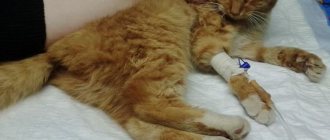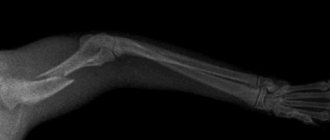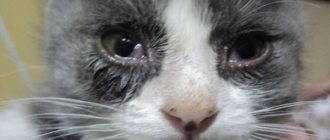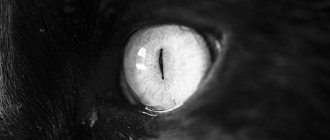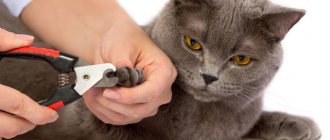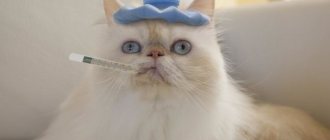Usually the owner treats the four-legged pet as a full-fledged member of the family. At times he worries about his health more than his own.
And this is justified, since the cat cannot say that something is bothering it. This happens, for example, when he breaks his paw. What to do in such a situation is below in the article.
Broken paw
Causes of fractures
A cat's paw fracture occurs for the following reasons:
- jump from height;
- receiving various injuries (inflicted by humans or animals);
- domestic injuries (mostly accidental);
- specially bred rare breeds do not have excellent health. They often have pathological bone fragility, which makes injuries much more common;
- infection, congenital pathologies, imbalances. Various external factors that weaken immunity and bone strength are taken into account.
For your information! The majority of fractures in felines occur in the limbs. Then in frequency there are fractures of the pelvis, tail and spine. The rarest is a skull fracture.
How to find out?
- becomes apathetic;
- prefers to lie down more;
- hiding;
- refuses food;
- limps;
- rises heavily to his feet;
- cannot stand up (pelvic fracture).
However, if a cat moves on three legs, this does not mean that it necessarily has a fracture. Perhaps a splinter got into the paw, making it painful to step on, a dislocation occurred, or the cat was injured or hurt.
Before administering first aid, carefully inspect the paw. A fracture is indicated by:
- strong pain;
- unnatural bone mobility;
- anatomically incorrect placement of the limbs (turned in the opposite direction);
- edema, swelling;
- crunch when palpated.
Upon examination, the cat will most likely scream and try to escape. Be kind to your pet. Before examination, calm the animal and place it on your lap. Try not to squeeze the paw too hard, gently probing with two fingers.
Classification of fractures
The cat's eyes are watery: what to do at home
There are many fractures, mainly divided into open and closed. Regardless of the type of injury, you do not need to treat the damaged paw yourself, much less set it. It is also better not to touch the cat or bother him over trifles. Such actions will worsen his well-being and provoke a state of shock. Or even worse, they will change the location of the bone, increasing the pain.
- Open fracture in a cat. An open fracture is characterized by breaks in the skin where the bone may be visible.
- Closed fracture. A closed fracture is characterized by unchanged skin, the place at first looks like a bruise.
How to tell if a cat has broken its paw
The main symptom of damage to the front or hind legs is limping, but the cat could have bruised the limb. Upon examination, a bruise may be detected or palpation may cause pain to the animal.
Urgent Care
A fracture is always very painful.
In such a situation, the cat may become aggressive, regardless of how calm it usually is. Secondly, such a serious injury as a fracture can cause shock and other not so obvious problems. Some of them may not appear for several days. Therefore, any home treatment can only stabilize the injury until your pet can be seen by a veterinarian.
Any areas that are bleeding or where bones are protruding should be covered with sterile gauze or a clean cloth if possible. Bones should be at maximum rest. Wrap your cat in a thick towel or place her on a hard surface to take to the veterinarian.
The cat broke its paw, what to do at home
If there is a suspicion that your pet has a fracture, it is important not to panic, not to feed the animal with available medications and not to solve the problem yourself by providing first aid.
Urinary incontinence in a cat: what to do at home
If your cat suddenly breaks its paw, you need to immediately take it to a veterinary clinic. If the fracture is open, the first step is to stop the bleeding. The arterial is stopped with a tourniquet, and the venous with a bandage, making a bandage.
Note! The injury itself cannot heal.
A small kitten broke its leg, what should I do? You will have to transport the injured pet to the hospital, preparing a hard sleeping place. It is best to apply a bandage to the injured paw.
So what to do if your cat breaks his paw?
First, you need to call the clinic where your pet will receive qualified medical care and make an appointment. First, they will diagnose you using x-rays and prescribe appropriate therapy.
Limb fixation
After calling the clinic, the animal will be transported. When providing first aid, they try to properly immobilize the limb by applying a tight bandage, splint or bandage. If there is a fracture of a cat’s paw, especially the front one (regardless of the exact location of the damage), possibly with displacement, then you need to carefully immobilize the cat’s paw, fixing it. The main thing is not to cause associated injuries and not to worsen the existing problem.
At home, a splint is made from a hard material (you can take a plastic or wooden object) and secure it tightly with a bandage.
Note! If a cat with an injury is aggressive, you should not even try to fix the broken leg; you need to put him in a carrier and bring him to the clinic.
To transport a cat to a veterinary clinic, you need to place it in a rigid transport container and close it. It is important to use a hard surface, especially if spinal fractures are suspected.
How to identify a bruise
The cat stops stepping on the limb, and if it does, with mild degrees of damage, it becomes noticeably lame, automatically transferring the weight of its body to other supports. There are several main signs of a bruise in a cat that will help the owner suspect a pathological condition and take the animal to a veterinary clinic.
The main symptoms of bruises are:
- swelling when a paw is bruised in the area of the affected limb (swelling develops against the background of accumulation of lymphatic fluid and blood from ruptured vessels into the subcutaneous fatty tissue);
- hematoma (bruise) at the site of the lesion;
- disturbance of the cat’s normal gait and severe lameness;
- the animal anxiously tries to lick the sore spot, stimulating microcirculation for speedy resorption of the bruise;
- an increase in temperature at the site of damage, but not locally;
- aggression of the pet when the owner tries to touch the damaged area.
At the same time, against the background of a bruise, the cat should not have any significant damage to the integrity of the skin, as well as violations of the joint and bones on the paw.
Severe or minor bruises of the first and second degree under normal conditions disappear within a week.
Swelling gradually decreases, gait normalizes, and the animal becomes normal. If the bruise is associated with damage to ligaments or muscle fibers, consultation and treatment cannot be avoided.
It is important to know how to correctly distinguish a true bruise from a possible fracture or dislocation. So, when a cat has fractures, there is a visual change in the structure of a limb or other damaged part of the body.
The pet experiences severe pain at the site of injury, plaintively asking for help.
By gently palpating the affected limb, the owner will be able to feel for instability of the bone. In addition, with fractures, edema develops not only in a certain place, but is distributed over large areas.
With dislocations, the clinical picture has the following characteristic feature. At the site of dislocation, the boundaries of the exit of the head of the bone from the articular capsule are clearly defined. The limb weighs like a whip, and the cat cannot use it. In such cases, you cannot set the bone yourself; you must contact a specialist.
Is a hospital needed for a cat with a fracture?
Diarrhea and vomiting in a cat: what to do at home
The postoperative period for a pet includes hospitalization of the cat until the owner is able to provide adequate control over its well-being. In the hospital, the pet undergoes all the necessary procedures, for example, injections, oxygen therapy or IVs, etc.
After providing pain relief and first aid, veterinarians will carry out the remaining diagnostic measures. If possible, the cat's condition will be checked twice a day. In the morning, take blood and secretions for testing.
Recovery in hospital
Veterinarians administer painkillers to an animal with a fracture in a state of traumatic shock, available only to doctors in a hospital. It will not be possible to organize treatment for a cat at home, since fast-acting drugs are not sold without a doctor’s prescription.
Diagnostics in a veterinary clinic
Diagnosis in a veterinary clinic should be aimed at identifying associated disorders, for example, hormonal imbalances, which may adversely affect the health of the animal. Serious pathologies are a contraindication for surgery. Activities aimed at treating a feline fracture include: initial examination, collection of tests (biochemistry), x-ray of the limb in several projections, ultrasound of the heart and other organs.
For your information! Polytrauma—several fractures—is often encountered in veterinary practice.
An orthopedic veterinarian will conduct a comprehensive examination, after which he will assess the sensitivity of the damaged paw and check the reflex. After this, the doctor will make sure that there are disorders that are associated with problems of the musculoskeletal system.
X-ray of a fracture
Then he proceeds to the next step - palpation. He palpates the paws and gives the animal pain relief. After identifying the problem area, the doctor begins a special examination method - radiography. X-rays are an effective and inexpensive way to examine a fracture in your pet.
Conservative method
Non-surgical therapy begins with an anesthetic. Afterwards, if necessary, the dislocation is reduced and a splint, a plaster cast, and a collar are applied to fix the damaged paw. Much depends on the cat’s behavior, since with aggressive behavior it will not be possible to complete the required steps properly.
Subsequent steps include prescribing medications to the animal to help restore bone tissue and relieve inflammation.
Note! The newest hospitals use effective physical therapy, which allows you to count on a speedy recovery and improved health.
When is surgery needed?
There are many reasons that will determine how to treat a fracture in a cat. The most important of them are the general health of the pet, the age of the pet, the type of injury and what bones it broke. At times, for injuries to the hind legs, a fixing bandage or splint is sufficient. If surgical intervention is still necessary, then a screw, pin (metal rod), wire or metal plate is installed into the cat’s bone to hold the bone fragments.
Treatment of injury is most often surgical; it includes fixation of bone fragments and ensuring stable preservation of the functions of damaged tissues. After surgical intervention, doctors prescribe therapeutic measures aimed at eliminating inflammation around the injury, healing and restoring the general condition.
Fracture treatment
Caring for a cat after surgery
During recovery, limit physical activity (including walks), visit a veterinarian as prescribed, give the cat vitamins, or, if the doctor recommends, switch the animal to health food, which helps restore bone tissue and regeneration.
If the veterinarian has applied a splint, cast or bandage, the owner must constantly monitor the bandage so as not to cause complications in the animal. The dressing should normally look like its original condition and be completely dry. Also, the condition of the tire is examined by a veterinarian at least three times a month.
Note! After visiting the veterinarian, the main thing is to follow his instructions. Also, after the cast and wires are removed, you need to allow time for recovery. According to experts, this may take more than a month. Recovery is monitored using radiography.
Prevention measures
The largest number of fractures are caused by injury, so it is better to limit the time the cat spends in the fresh air. This will minimize the risk of injury from cars and eliminate the possibility of encountering other animals. It is worth paying attention to the behavior and habits of your pet when he comes back from a walk.
The cat broke his paw
The most common injury among domestic cats is a broken paw, most often the hind paw. Fluffy pets often go for walks unattended, sleep under cars, walk on window sills or climb tall trees. All of the above can cause a fracture.
All owners love their animals and become confused and scared, not knowing what to do in a given situation. The main thing is to gather your thoughts and, in case of such injuries, urgently call a specialist. The veterinarian will provide first aid and save the pet.
What are the consequences?
After a fracture, complications may occur, such as:
Tetanus bacillus can be introduced into an animal's wound when it receives an open type of injury.
- Muscular atrophy. Occurs in combination with spinal injury, when the neurons of the spinal cord are affected. The hind legs hardly function, and the cat drags them, sensitivity decreases.
- Secondary infection. Open injuries are dangerous because staphylococcus, Pseudomonas aeruginosa, and tetanus bacteria enter the wound, which can be fatal.
- Arthrosis. The cartilage is destroyed and the legs look crooked, they hurt, and the cat cannot position them normally when moving.
